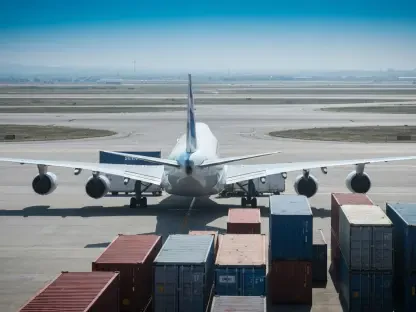In the modern world, global supply chains face unprecedented challenges, notably concerning the management and tracking of reusable transport packaging (RTP). These essential components, including pallets, crates, and bins, serve as the backbone of international logistics, yet they are often mishandled due to inefficiencies in traditional tracking systems. Overcoming these chronic issues is paramount to ensuring smooth operations within supply chains. Ambient IoT represents an innovative leap forward, promising to overhaul conventional methodologies and provide solutions to longstanding issues.
Explaining the Challenge of Conventional Tracking Systems
Traditional Technologies and Their Limitations
Technological advancements have long been sought after in supply chains to track RTPs with precision and accuracy. However, traditional methods employing barcodes, QR codes, RFID, and GPS face hurdles that significantly limit their implementation. The infrastructure required for these systems is often cumbersome, and the deployment processes are slow and inherently inconsistent. These drawbacks lead to ineffective tracking, frequently resulting in asset loss and compromised operational integrity. Supply chains grapple with the challenge of maintaining seamless and efficient logistics, where the inability to apply these systems uniformly across various settings exacerbates logistical woes.
Asset loss due to ineffective tracking is not just a trivial inconvenience; it significantly impacts financial expenses and supply chain operations. Without reliable tracking, organizations resort to over-purchasing and stockpiling assets as a buffer against losses. This practice is both economically draining and unsustainable, accruing significant expenses over time. Parallels drawn to historical tales, such as losing a kingdom for a simple nail, illustrate the severity of a missing RTP’s effect on business contracts and relationships. Companies suffer as their inability to promptly locate essential packaging results in delayed shipments, lost clients, and wasted resources.
Financial Strain Due to Inefficiencies
The financial repercussions of inadequate tracking systems have escalated, casting shadows over businesses as they seek viable solutions. The necessity to overstock assets to compensate for lost ones presents a considerable financial burden, often running into billions. By prioritizing excess inventory over efficiency, companies undermine their fiscal stability and operational foresight. Beyond financial losses, the erroneous management of RTPs impacts customer relations and ultimately jeopardizes trusted contracts. Losing track of RTPs can lead to delays and disruptions in fulfilling delivery commitments, risking client dissatisfaction and tarnishing reputations. Understanding the economic impact is crucial for propelling industries toward efficient solutions that herald sustainable practices.
Tracing these inefficiencies not only underscores the economic impact but also highlights the cascading effect on client relationships and contractual obligations. Missing RTPs can directly jeopardize business integrity, diminishing trust and reliability in client interactions. This fragility is compounded by unforeseen costs and logistical turmoil arising from asset losses, creating a taxing environment for businesses to navigate. Addressing this strain and its far-reaching implications requires an innovative approach that shifts the focus from compensating lost revenues to optimizing asset management through robust tracking technologies capable of real-time intelligence and location accuracy.
Introducing Ambient IoT as a Solution
Ambient IoT’s Innovative Approach
Ambient IoT emerges as a beacon of technological innovation, reshaping how RTPs are managed in modern supply chains. Seamlessly integrating artificial intelligence within the Internet of Things (IoT) framework, Ambient IoT introduces an avant-garde approach to tracking logistics. Through the deployment of ultra-thin stickers, mass-produced at scale, RTPs become visible entities within the digital landscape. These stickers equip assets with the ability to connect to the cloud, bestowing them with real-time intelligence regarding their whereabouts and environment. Ambient IoT’s breakthrough lies in its capacity to offer detailed insights into assets’ conditions—ranging from temperature to humidity—thus amplifying operational dynamics.
By challenging traditional constraints of cost and location, Ambient IoT revolutionizes the landscape of asset management. Its application within supply chains holds the potential to enhance efficiency remarkably, promising a swift return on investment. The low-cost model and scalability eliminate barriers linked to conventional tracking methods while ensuring that RTPs are operationally optimized. This shift from inefficient tracking to intelligent asset monitoring fosters real-time opportunities to efficiently manage, strategize, and respond to logistics challenges seamlessly, contributing to a more streamlined supply chain ecosystem.
Utilization of the Bluetooth Network
The widespread presence of Bluetooth technology, prevalent in billions of everyday devices, provides Ambient IoT with an optimal platform to connect RTPs seamlessly. By harnessing this existing infrastructure, Ambient IoT integrates RTPs into comprehensive digital ecosystems, transforming them into smart assets that are ready for strategic management and oversight. The connectivity facilitated by Bluetooth networks empowers RTPs with enhanced visibility, allowing businesses to monitor location, movement, and environmental conditions efficiently.
Enabling access to intuitive dashboards and real-time alerts, Ambient IoT offers user-friendly interfaces for tracking and managing RTPs with precision. Through push notifications and synchronized data, businesses gain operational insights that transcend traditional tracking barriers, unveiling blind spots that hindered optimal logistics previously. Not only does this connectivity foster seamless oversight, but it aligns with sustainability goals by minimizing RTPs as single-use entities due to inefficiencies. Ambient IoT thus paves the way for sustainable asset utilization, continually informing operational strategies in the digital era.
Operational Benefits and Competitive Advantage
Advantages of Implementing Ambient IoT
The deployment of Ambient IoT within supply chains heralds significant operational benefits that extend beyond mere asset tracking. A crucial advantage lies in its ability to address and resolve “temperature excursions,” which can lead to spoilage and waste during transport. By delivering real-time insights into asset conditions, Ambient IoT enables businesses to implement proactive measures that safeguard against losses in transport quality. Reduced labor costs emerge as a product of efficient locating mechanisms, mitigating time and resources spent on manual searches for missing RTPs while minimizing billing discrepancies. This advancement ushers in efficiency, allowing businesses to reallocate efforts toward optimizing logistics operations comprehensively.
With streamlined processes resulting from Ambient IoT integration, businesses also benefit from minimized shrinkage and asset replacement expenses. The expeditious identification of inefficiencies facilitates lower costs associated with asset renewal, ensuring better fiscal management and operational integrity. Through Ambient IoT, businesses harness advanced technologies that prioritize intelligent asset management and deter the complications inherent in traditional methodologies. An astute attention to detail in tracking RTPs generates tangible savings and promotes long-term business growth, cultivating resilience in a competitive market.
Achieving Sustainable and Competitive Edge
In today’s globalized environment, managing and tracking reusable transport packaging (RTP) poses considerable challenges for global supply chains. These packaging elements, including pallets, crates, and bins, are integral to international logistics, serving as the backbone of these operations. However, traditional tracking systems are often plagued by inefficiencies, leading to mismanagement and mishandling of these crucial components. Addressing these persistent issues is essential for maintaining efficient supply chain operations that rely on the seamless movement of goods across borders. Ambient IoT is emerging as a revolutionary technology aimed at transforming existing methodologies. By integrating IoT solutions, companies can potentially eliminate historical obstacles, enhancing accuracy and efficiency in the tracking of RTP across various stages of the supply chain. This breakthrough promises to ensure smoother logistics operations and might pave the way for more agile and responsive supply chain networks.









